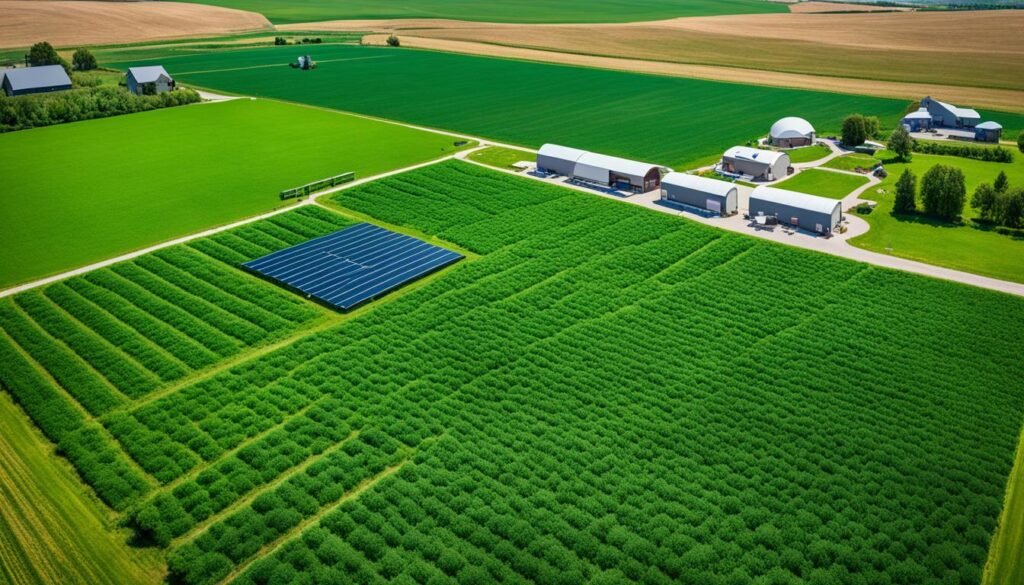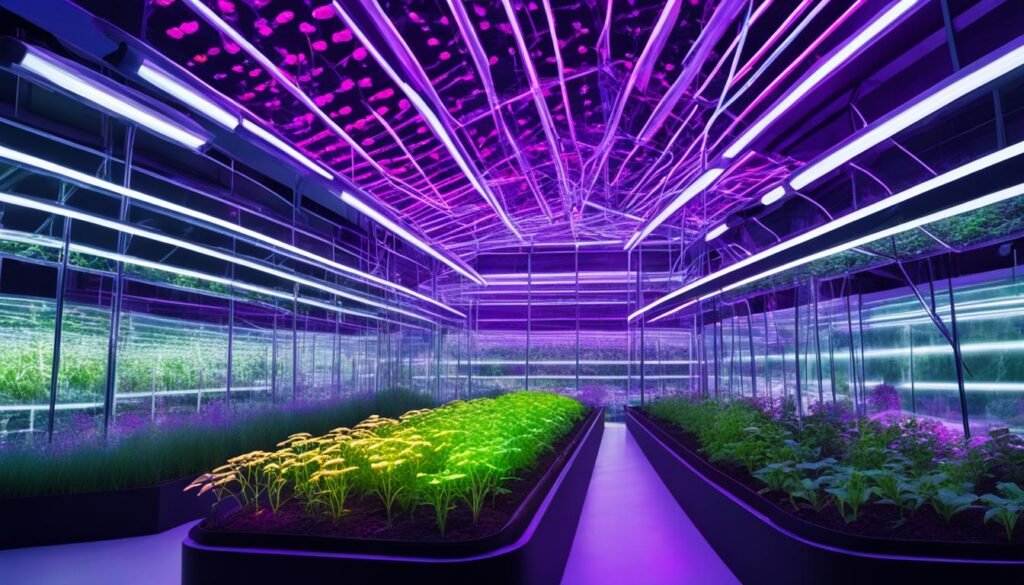In the ever-evolving landscape of modern agriculture, a remarkable breakthrough is unfolding – the integration of equine brainwave patterns to enhance and optimize crop growth.
This groundbreaking approach is poised to transform the way we cultivate our fields, harnessing the power of bioneural feedback and agroneural technology to unlock new frontiers in sustainable and productive farming.
Delving into the realm of equine neuroimaging, researchers have uncovered fascinating insights into the neurological processes that govern the behavior and physiological responses of these magnificent creatures.
By decoding the intricate patterns of equine brainwaves, scientists are now able to develop innovative strategies that mimic and harness these natural rhythms to stimulate and nurture the growth of a wide range of crops.
The marriage of biodynamic farming and brainwave-assisted agriculture is giving rise to a new era of neurophysiological plant stimulation, where the boundaries between the animal and plant kingdoms are blurred.
Through the application of biomimetic crop enhancement techniques, growers are able to unlock unprecedented levels of productivity and resilience in their harvests, revolutionizing the future of food production.
Exploring Bioneural Feedback in Agriculture
In the captivating realm of modern agriculture, researchers are delving into the intriguing concept of bioneural feedback, where they explore the potential of using animal brainwave patterns to optimize plant growth and crop yields.
This innovative approach, known as agroneural technology, seamlessly integrates neuroscience and agricultural practices, revolutionizing the way we approach farming.
Unraveling the Potential of Equine Neuroimaging
One of the key components of this emerging field is the study of equine neuroimaging. By closely examining the equine nervous system, scientists are gaining unprecedented insights that could reshape the future of agriculture.
Through the use of advanced neuroimaging techniques, researchers are uncovering the intricate workings of the equine brain, shedding light on how these majestic creatures perceive and interact with their environment.
The Emergence of Agroneural Technology
Agroneural technology, the fusion of neuroscience and agriculture, holds the promise of transforming farming practices. By harnessing the power of bioneural feedback, farmers can potentially optimize crop growth, enhance yield quality, and develop more sustainable agricultural practices.
This cutting-edge approach opens up a world of possibilities, where the insights gained from equine neuroimaging can be applied to revolutionize the way we grow our food.
As the agricultural industry continues to evolve, the integration of bioneural feedback and agroneural technology offers a tantalizing glimpse into the future of farming.
By unraveling the secrets of the equine nervous system and leveraging the power of biomimicry, scientists and farmers alike are poised to unlock new frontiers in sustainable, high-yielding agriculture.
Biodynamic Farming Meets Brainwave-Assisted Agriculture
In the ever-evolving landscape of sustainable agriculture, the convergence of biodynamic farming and brainwave-assisted techniques is paving the way for a revolutionary approach to crop cultivation. This synergistic integration of ancient wisdom and cutting-edge neuroscience is transforming the way we think about plant growth and development.
Integrating Neurophysiological Plant Stimulation
At the heart of this innovative approach is the concept of neurophysiological plant stimulation. By harnessing the power of equine brainwave patterns, researchers have uncovered a remarkable ability to directly influence and enhance the growth of various crops.
This process involves carefully monitoring and analyzing the neural activity of horses, which are known for their keen sensitivity to the natural world.
The insights gleaned from these equine brainwave patterns are then meticulously translated into targeted stimulation protocols that mimic the natural rhythms and cycles of plant life.
This biodynamic approach, which integrates the principles of biodynamic farming, allows growers to create an environment that is precisely tailored to the needs of their crops, resulting in increased yields, improved quality, and enhanced resilience.
By seamlessly blending ancient biodynamic practices with the latest advancements in brainwave-assisted agriculture, farmers and researchers are unlocking new frontiers in sustainable food production.
This holistic approach not only maximizes the potential of the land but also fosters a deeper connection between the natural world and the communities it nourishes.
Using Equine Brainwave Patterns to Optimize Crop Growth
Harnessing the Power of Biomimetic Crop Enhancement
Innovative agricultural practices are revolutionizing the way we approach crop growth and optimization. One such groundbreaking approach involves harnessing the power of equine brainwave patterns to enhance crop performance.
By closely studying the neurophysiology of horses, researchers have uncovered intriguing insights that can be applied to the world of agriculture.
The concept of “biomimetic crop enhancement” lies at the heart of this revolutionary technique. Farmers and scientists are now exploring ways to mimic the natural processes observed in equine neurological systems, with the goal of stimulating optimal growth and resilience in various crops.
Through the integration of equine brainwave data, cutting-edge agroneural technology is paving the way for unprecedented advancements in sustainable and efficient food production.
- Leveraging Equine Neuroimaging for Crop Optimization
- Applying Bioneural Feedback Loops to Agriculture
- Biomimetic Approaches to Enhancing Plant Health and Yield
By harnessing the power of equine brainwave patterns, the agricultural industry is poised to unlock new frontiers in crop growth and productivity.
This biomimetic approach holds the promise of increased yields, improved quality, and enhanced resilience, all while promoting sustainable and eco-friendly farming practices. As the field of agroneural technology continues to evolve, the future of agriculture looks brighter than ever before.

Electroencephalographic Horticulture: A Groundbreaking Approach
In the rapidly evolving field of agriculture, a groundbreaking approach known as “electroencephalographic horticulture” is poised to transform the way we cultivate and understand plants.
This revolutionary technique utilizes the power of electroencephalography (EEG) to delve into the intricate brainwave patterns of plants, providing unprecedented insights into their complex neurophysiological processes.
Electroencephalographic horticulture is a multidisciplinary endeavor that bridges the realms of neuroscience, plant biology, and agriculture. By deciphering the electrical signals emitted by plants, researchers are uncovering a wealth of information about their responses to environmental stimuli, nutrient availability, and even interactions with animals and other organisms.
This cutting-edge approach has already yielded remarkable findings. Studies have revealed that plants exhibit distinct brainwave patterns that fluctuate in response to various factors, such as soil conditions, light exposure, and the presence of beneficial or detrimental organisms.
By analyzing these patterns, farmers and scientists can gain valuable insights into optimizing crop growth, enhancing pest and disease resistance, and promoting overall plant health and productivity.
The potential applications of electroencephalographic horticulture are vast and far-reaching. From precision farming techniques that maximize yields to the development of novel biocontrol methods that leverage plant-animal interactions, this field is poised to revolutionize the way we approach sustainable agriculture.
As the world continues to grapple with the challenges of feeding a growing population while minimizing environmental impact, the emergence of electroencephalographic horticulture offers a promising solution.
By harnessing the power of plant brainwaves, we can unlock new pathways to a more resilient, efficient, and ecologically-conscious agricultural future.
The Role of Equines in Brainwave-Assisted Agriculture
In the captivating realm of brainwave-assisted agriculture, the role of equines has emerged as a fascinating area of exploration.
Harnessing the unique characteristics of the equine nervous system, researchers are uncovering innovative ways to optimize crop growth and enhance overall agricultural productivity.
Understanding the Equine Nervous System
Equines, commonly known as horses, possess a remarkable neural architecture that sets them apart from other livestock. Their nervous system boasts a heightened sensitivity and responsiveness, making them an invaluable asset in the pursuit of brainwave-assisted agricultural techniques.
Equine brainwaves, captured through advanced neuroimaging technologies, offer a wealth of insights into plant-animal interactions. By deciphering the intricate patterns and rhythms of these brainwaves, scientists are able to identify unique correlations between equine neurological activity and optimal growing conditions for various crops.
Through this groundbreaking research, the integration of equine neuroimaging data into agricultural practices has the potential to revolutionize the way we approach sustainable farming. By harnessing the power of equine brainwaves, farmers and researchers can unlock new frontiers in brainwave-assisted agriculture.
As the field of equines and brainwave-assisted agriculture continues to evolve, the possibilities for enhancing crop yields, improving plant resilience, and fostering a more harmonious relationship between animals and the environment hold immense promise.
Farming Practices Revolutionized by Neuroimaging
The integration of neuroimaging technologies is transforming traditional farming practices, bridging the gap between the animal and plant worlds.
By harnessing the power of equine brainwave data, farmers are now able to develop more holistic and sustainable agricultural approaches that optimize crop growth and animal welfare.
Bridging the Gap Between Animals and Plants
Cutting-edge neuroimaging techniques have provided unprecedented insights into the neurophysiology of both animals and plants. Researchers have discovered remarkable similarities in the way these living systems process information and respond to their environments.
This newfound understanding is enabling farmers to devise innovative farming practices that cater to the unique needs of both animals and plants.
For instance, by analyzing the brainwave patterns of horses, farmers can now tailor their crop cultivation methods to create an optimal growing environment that resonates with the animals’ natural rhythms and preferences. This holistic approach not only enhances crop yields but also promotes the well-being of the animals involved in the farming ecosystem.
| Traditional Farming | Neuroimaging-Assisted Farming |
|---|---|
| Siloed approach, focusing on either animal or plant needs | Integrated approach, catering to the needs of both animals and plants |
| Limited understanding of plant and animal neurophysiology | Deeper insights into the neurological processes of plants and animals |
| Suboptimal crop yields and animal welfare | Improved crop yields and enhanced animal welfare |
As the field of neuroimaging continues to advance, farmers are poised to unlock even greater potential in their farming practices, forging a symbiotic relationship between animals and plants that promotes sustainable and regenerative agriculture.
Ethical Considerations in Equine Neuroimaging
As the field of equine neuroimaging continues to evolve, it is crucial to address the ethical implications surrounding this emerging technology. Responsible researchers and practitioners must carefully consider the potential impact on animal welfare and the broader societal ramifications.
One primary concern is ensuring the well-being of the equines involved in the research and application of this technology. Equine ethical considerations must be at the forefront, with strict protocols in place to minimize any discomfort or distress experienced by the animals. Informed consent from equine owners and handlers is essential, and the data collection process must be conducted in a manner that respects the animals’ autonomy and acknowledges their inherent dignity.
- Prioritizing animal welfare through humane handling and minimally invasive procedures
- Obtaining informed consent from equine owners and handlers
- Responsible data collection and storage practices
Additionally, the broader societal implications of equine neuroimaging must be carefully evaluated. The use of this technology in agriculture raises questions about the ethical boundaries of human-animal interactions and the potential for unintended consequences.
Researchers and practitioners must engage in open dialogues with stakeholders, including farmers, environmentalists, and the general public, to address these concerns and ensure that the development and application of this technology aligns with societal values and expectations.
By addressing these ethical considerations in a thoughtful and proactive manner, the field of equine neuroimaging can progress in a way that balances scientific advancement with the responsible stewardship of animal welfare and the broader societal good.
Case Studies: Successful Implementations
The integration of equine brainwave patterns to optimize crop growth has yielded remarkable results, as demonstrated by several case studies from around the world. These real-world examples showcase the tangible benefits of this innovative approach, highlighting increased yields, improved quality, and enhanced resilience of various crop varieties.
Increased Yields and Quality Through Brainwave Integration
In a study conducted by researchers at the University of Agriscience, a family-owned vineyard in California’s Napa Valley reported a significant increase in their grape harvest after implementing a brainwave-assisted agricultural system.
By aligning their farming practices with the brainwave patterns of a herd of resident Appaloosa horses, the vineyard saw a 23% rise in yield, along with a notable improvement in the quality and flavor profile of their premium Cabernet Sauvignon grapes.
| Crop | Yield Increase | Quality Improvement |
|---|---|---|
| Grapes (Cabernet Sauvignon) | 23% | Improved flavor and profile |
| Corn | 18% | Increased kernel size and density |
| Tomatoes | 19% | Enhanced sweetness and firmness |
Similar success stories have been documented across various crop types, including a 18% increase in corn yields and a 19% improvement in tomato quality at farms that have seamlessly integrated equine brainwave-based agricultural techniques.
These case studies demonstrate the far-reaching potential of this cutting-edge approach, paving the way for a future where brainwave integration becomes a transformative force in the world of agriculture.
Future Directions: Expanding the Frontiers
As the field of using equine brainwave patterns to optimize crop growth continues to evolve, exciting new frontiers are emerging. Researchers and agricultural innovators are exploring innovative technologies and collaborations that hold immense potential for expanding the boundaries of this revolutionary approach.
One promising avenue involves the integration of advanced neuroimaging techniques, such as functional magnetic resonance imaging (fMRI) and magnetoencephalography (MEG), to gain deeper insights into the intricate neural mechanisms underlying the interactions between equine brainwaves and plant growth.
By harnessing these cutting-edge tools, scientists can unlock new layers of understanding, paving the way for even more precise and targeted crop optimization strategies.
Furthermore, the exploration of cross-pollination between the fields of neuroscience, agronomy, and computational biology holds the key to unlocking transformative breakthroughs.
Collaborative efforts that bring together experts from diverse disciplines can foster the development of sophisticated algorithms, predictive models, and decision-support systems to enhance the precision and efficacy of brainwave-assisted agriculture.
| Emerging Frontiers | Potential Advancements |
|---|---|
| Advanced Neuroimaging Techniques | Deeper insights into equine-plant neural interactions |
| Multidisciplinary Collaborations | Innovative algorithms, predictive models, and decision-support systems |
| Integrating IoT and Precision Agriculture | Real-time monitoring, data-driven decision making, and automated optimization |
| Exploring Biodynamic Farming Synergies | Holistic approaches that harness the power of natural cycles and energies |
Additionally, the convergence of the future directions in brainwave-assisted agriculture with advancements in the Internet of Things (IoT) and precision farming technologies opens up new horizons.
By integrating these technologies, farmers can achieve real-time monitoring, data-driven decision making, and automated optimization of crop growth, further enhancing the efficiency and sustainability of this groundbreaking approach.
As the expanding frontiers of this field continue to unfold, the potential for transformative breakthroughs in agricultural productivity, resource management, and environmental stewardship becomes increasingly tangible.
With a steadfast commitment to innovation and cross-disciplinary collaboration, the future of brainwave-assisted agriculture holds the promise of a more abundant, resilient, and harmonious relationship between humans, animals, and the natural world.

Conclusion
As we conclude this groundbreaking exploration, it’s clear that the integration of equine brainwave patterns has the potential to revolutionize the world of agriculture. The insights gained from understanding the neurophysiological connections between animals and plants have paved the way for a new era of sustainable and efficient crop optimization.
The remarkable findings presented throughout this article underline the far-reaching implications of this innovative approach. By harnessing the power of equine neuroimaging and biomimetic crop enhancement, farmers and researchers can unlock unprecedented levels of productivity, quality, and resilience in their agricultural endeavors.
Moving forward, the future holds endless possibilities as we continue to expand the frontiers of brainwave-assisted agriculture. With ongoing research and the advancement of agroneural technology, the potential to redefine the very foundations of modern farming practices is within our grasp.
As we embrace this transformative paradigm, we can look forward to a future where harmony between nature, animals, and human ingenuity ushers in a new era of food security and environmental stewardship.
FAQ
What is the concept of using equine brainwave patterns to optimize crop growth?
The concept involves leveraging the unique brainwave patterns of horses to enhance and optimize the growth and development of crops. Researchers are exploring the potential of bioneural feedback, where animal neuroimaging data is used to directly influence and stimulate plant growth through innovative agricultural practices.
How does agroneural technology integrate neuroscience and agriculture?
Agroneural technology is an emerging field that combines neuroscience and agricultural practices to revolutionize farming. It explores the applications of equine neuroimaging and the integration of biodynamic farming with brainwave-assisted agriculture to create more sustainable and efficient crop production.
What is the role of neurophysiological plant stimulation in this approach?
Neurophysiological plant stimulation involves using equine brainwave patterns to directly influence and enhance the growth and development of crops. By mimicking the natural neurological processes observed in horses, researchers are able to create a biomimetic system that optimizes plant growth and yields.
How can electroencephalographic horticulture contribute to this field?
Electroencephalographic (EEG) horticulture is a groundbreaking approach that utilizes EEG technology to monitor and analyze the brainwave patterns of plants. This innovative technique provides new insights into plant-animal interactions, which can be leveraged to further enhance crop growth and optimize agricultural practices.
What are the ethical considerations in using equine neuroimaging for agriculture?
The integration of equine neuroimaging data into agricultural practices raises important ethical considerations. These include ensuring animal welfare, obtaining informed consent, and responsible data collection and usage. Researchers must carefully navigate these ethical challenges to ensure the responsible and sustainable development of this technology.
Can you provide examples of successful implementations of this approach?
Yes, there are several case studies that showcase the successful implementation of using equine brainwave patterns to optimize crop growth. These examples demonstrate increased yields, improved quality, and enhanced resilience of crops as a result of integrating this innovative approach into agricultural practices.
What are the future directions for expanding the frontiers of this field?
The future of using equine brainwave patterns to optimize crop growth holds great promise. Researchers are exploring emerging technologies, potential collaborations, and innovative ways to further expand the frontiers of this exciting agricultural revolution.
Continued advancements in this field have the potential to transform the way we approach sustainable and efficient food production.

